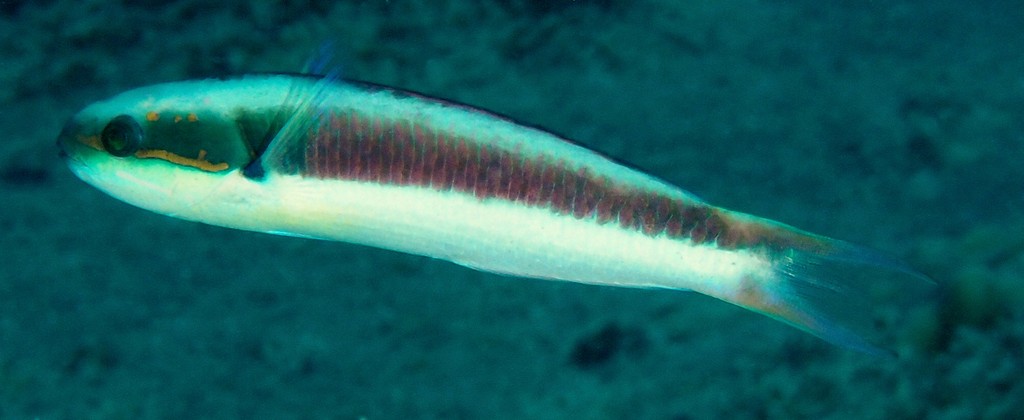THALASSOMA AMBLYCEPHALUM - (BLEEKER, 1856)
Actinopterygii (Gigaclass) > Actinopteri (Class) > Teleostei (Subclass) > Labriformes (Order) > Labroidei (Suborder) > Labridae (Family) > Thalassoma (Genus)
Girelle bariolée, Girelle à tête obtuse, Girelle paon bigarrée, Bluehead wrasse, Bluntheaded wrasse, Moon wrasse, Paddle-fin wrasse, Rainbow wrasse, Twotone wrasse, Tweekleur-lipvis, Zweifarben-Junker, Kogashirabera, コガシラベラ, 鈍頭錦魚, 钝头锦鱼,
Synonymes
Julis amblycephalus (Bleeker, 1856)
Julis melanochir (Bleeker, 1857)
Pseudojulis trifasciatus (Weber, 1913)
Pseudojuloides trifasciatus (Weber, 1913)
Thalassoma amblycephala (Bleeker, 1856)
Thalassoma amblycephalus (Bleeker, 1856)
Thalassoma marnae (Schultz, 1943)
Thalassoma melanochir (Fowler, 1904)
Thalassoma melanochir (Bleeker, 1857)
------------------------------
Description
Dorsal spines (total): 8; Dorsal soft rays (total): 13; Anal spines: 3; Anal soft rays: 10-11; Pectoral fin rays: 15; Lateral line scales: 26-27; Head scaleless; Scales on thorax about half size of those on body; Gill rakers: 16-19; Jaws with one pair of canine teeth anteriorly, followed by progressively shorter conical teeth; No canine at corner of mouth; Body depth: 3.8-4.2 in SL; Caudal fin truncate to slightly emarginate, becoming lunate in large males. Max. length: 16.0 cm SL. Depth range: 1 - 15 m.
Color
Males usually have a a green to bluish-green head, a yellow band around the anterior body followed by a pinkish body, a yellow pectoral fin with a broad blue outer margin, and a lunate tail.
Juveniles have a broad dark stripe from snout through eye to the caudal-fin base, and yellow upper and lower parts of the caudal peduncle and caudal-fin lobes.
Etymology
Thalassoma: from Greek, thalassa = the sea + from Greek, soma = body; Referring to the color of the sea.
amblycephalum: from Greek, amblys or amblus = dull (blade: not sharp), blunt, obtuse + from Greek kephalē = head.
Original description: Julis amblycephalus Bleeker, 1856 - Type locality: Ora Malang, southeastern Java, Indonesia.
Distribution
Indo-West Pacific: South Africa, East Africa, Socotra, Seychelles, Comoros, Madagascar and Mascarenes east to Line Islands, Marquesas Islands and Tuamotu Archipelago, north to southern Japan and Ogasawara Islands, south to Australia, Lord Howe Island, New Caledonia, northern New Zealand, Kermadec Islands and Tonga.
Biology
Occurs in aggregations over shallow lagoon and seaward reefs and on reef flats. Feeds mainly on crustacean zooplankton. Spawns at dusk above reefs. Rarely marketed.
Similar species
Diproctacanthus xanthurus (Bleeker, 1856) - Reported from New Caledonia. Juveniles with 3 broad black stripes from head to caudal fin where the stripes merge; With growth, lower stripe disappears, upper stripe is less distinct; Black caudal fin becomes entirely yellow in adults. Head scales small. Lips thick and fleshy, forming a short tube when mouth is closed. Caudal fin rounded to truncate; Pelvic fins rounded.
Girelle bariolée, Girelle à tête obtuse, Girelle paon bigarrée, Bluehead wrasse, Bluntheaded wrasse, Moon wrasse, Paddle-fin wrasse, Rainbow wrasse, Twotone wrasse, Tweekleur-lipvis, Zweifarben-Junker, Kogashirabera, コガシラベラ, 鈍頭錦魚, 钝头锦鱼,
Synonymes
Julis amblycephalus (Bleeker, 1856)
Julis melanochir (Bleeker, 1857)
Pseudojulis trifasciatus (Weber, 1913)
Pseudojuloides trifasciatus (Weber, 1913)
Thalassoma amblycephala (Bleeker, 1856)
Thalassoma amblycephalus (Bleeker, 1856)
Thalassoma marnae (Schultz, 1943)
Thalassoma melanochir (Fowler, 1904)
Thalassoma melanochir (Bleeker, 1857)
------------------------------
Description
Dorsal spines (total): 8; Dorsal soft rays (total): 13; Anal spines: 3; Anal soft rays: 10-11; Pectoral fin rays: 15; Lateral line scales: 26-27; Head scaleless; Scales on thorax about half size of those on body; Gill rakers: 16-19; Jaws with one pair of canine teeth anteriorly, followed by progressively shorter conical teeth; No canine at corner of mouth; Body depth: 3.8-4.2 in SL; Caudal fin truncate to slightly emarginate, becoming lunate in large males. Max. length: 16.0 cm SL. Depth range: 1 - 15 m.
Color
Males usually have a a green to bluish-green head, a yellow band around the anterior body followed by a pinkish body, a yellow pectoral fin with a broad blue outer margin, and a lunate tail.
Juveniles have a broad dark stripe from snout through eye to the caudal-fin base, and yellow upper and lower parts of the caudal peduncle and caudal-fin lobes.
Etymology
Thalassoma: from Greek, thalassa = the sea + from Greek, soma = body; Referring to the color of the sea.
amblycephalum: from Greek, amblys or amblus = dull (blade: not sharp), blunt, obtuse + from Greek kephalē = head.
Original description: Julis amblycephalus Bleeker, 1856 - Type locality: Ora Malang, southeastern Java, Indonesia.
Distribution
Indo-West Pacific: South Africa, East Africa, Socotra, Seychelles, Comoros, Madagascar and Mascarenes east to Line Islands, Marquesas Islands and Tuamotu Archipelago, north to southern Japan and Ogasawara Islands, south to Australia, Lord Howe Island, New Caledonia, northern New Zealand, Kermadec Islands and Tonga.
Biology
Occurs in aggregations over shallow lagoon and seaward reefs and on reef flats. Feeds mainly on crustacean zooplankton. Spawns at dusk above reefs. Rarely marketed.
Similar species
Diproctacanthus xanthurus (Bleeker, 1856) - Reported from New Caledonia. Juveniles with 3 broad black stripes from head to caudal fin where the stripes merge; With growth, lower stripe disappears, upper stripe is less distinct; Black caudal fin becomes entirely yellow in adults. Head scales small. Lips thick and fleshy, forming a short tube when mouth is closed. Caudal fin rounded to truncate; Pelvic fins rounded.
